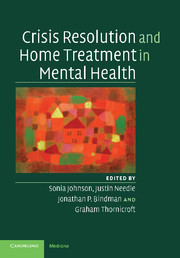Book contents
- Frontmatter
- Contents
- List of contributors
- Foreword
- Acknowledgements
- Section 1 Introduction and concepts
- 1 Introduction
- 2 The development of crisis resolution and home treatment teams
- 3 The crisis resolution team model: recent developments and dissemination
- Section 2 The evidence
- Section 3 Current practice
- Section 4 Variations and enhancements
- Section 5 Developing a local service
- Index
- References
2 - The development of crisis resolution and home treatment teams
from Section 1 - Introduction and concepts
Published online by Cambridge University Press: 13 August 2009
- Frontmatter
- Contents
- List of contributors
- Foreword
- Acknowledgements
- Section 1 Introduction and concepts
- 1 Introduction
- 2 The development of crisis resolution and home treatment teams
- 3 The crisis resolution team model: recent developments and dissemination
- Section 2 The evidence
- Section 3 Current practice
- Section 4 Variations and enhancements
- Section 5 Developing a local service
- Index
- References
Summary
The history of crisis resolution and home treatment teams (CRTs) has not previously been very clearly documented. This chapter fills this gap by describing the development of the CRT model, identifying its main precursors and the contributions they have made to the current model. The focus will be on services for adults of working age, and an overview will be given of the history and characteristics of the main models that have contributed to the development of current CRTs. Research evaluations of these models are discussed in Chapters 4 and 5.
Information sources used in this history
The authors carried out a literature search regarding CRTs and other forms of intensive home treatment delivered in a crisis. They looked particularly for descriptions of how the models that appeared to be CRT precursors were organised and operated, and of their origins, including any theories that had informed their development and research evidence or clinical observations that influenced them.
As relevant written sources are few, one of the authors (SJ) also carried out a series of interviews with key people involved in the development of CRTs and their precursors. Box 2.1 lists these people and says a little about them. The interviews took place in the course of 2002 and 2003 in a variety of locations, including participants' offices, a conference centre, one participant's home and Terminal 3 at Heathrow airport. Two interviews were carried out by phone.
- Type
- Chapter
- Information
- Publisher: Cambridge University PressPrint publication year: 2008
References
- 9
- Cited by



